Kid Feed
- Home
- Kid Feed

- 0 Comments
- admin
Turmoil: the predominant condition of Port-au-Prince that affects the rest of the country. Les Cayes is mostly calm, on occasion, trouble from the capital will make its way here to a lesser extent, but is still disruptive. Roads blocked with burning tires and debris shuts down commerce, which harms local businesses. Everyone is affected, but
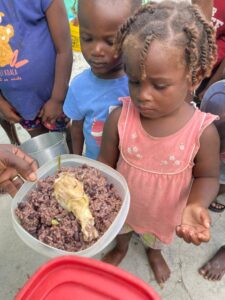
those who have the least suffer the most. Such was the case in the summer of 2020 for the people of Sou Wòch, my wife’s village west of Les Cayes. On top of the political trouble, fuel shortages and road blocks, the seasonal influx of seaweed was much heavier that year. Huge rafts of sargas, like floating, brown ribbons, could be seen drifting into shore, washing up and piling up on the beach. This put a halt to the primary fishing methods used in Sou Wòch. One day, Hertha pointed out to me that there were a lot of hungry children in her village. Pointing out means, “What are we going to do about it?”
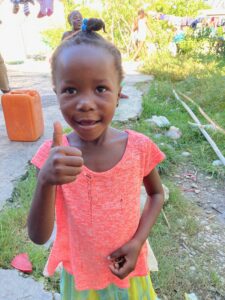 I started giving food to people the first semester I began teaching at the American University of the Caribbean in Les Cayes in 2014. Usually on Sunday morning, I would leave my living quarters at the school with a bag of peanut butter and jelly sandwiches (whole grain bread) and bottles of water, walk down the road and look for moun fou, street people, and give them two sandwiches and a bottle of water. I did that until Hurricane Matthew struck in October, 2016. I had met Hertha about a month or so before.
I started giving food to people the first semester I began teaching at the American University of the Caribbean in Les Cayes in 2014. Usually on Sunday morning, I would leave my living quarters at the school with a bag of peanut butter and jelly sandwiches (whole grain bread) and bottles of water, walk down the road and look for moun fou, street people, and give them two sandwiches and a bottle of water. I did that until Hurricane Matthew struck in October, 2016. I had met Hertha about a month or so before.
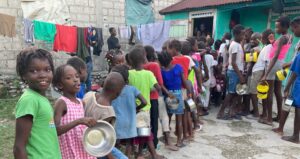
 After the storm, people from my church in Oregon started sending me money to buy food for those who needed it most. The Cat. 4 hurricane, had devastated south Haiti, which was followed by a flurry of relief efforts, but many people were left out. Hertha would go with me on the back of my moto for my safety and to make sure that I found rice and beans at the best price. That’s when I realized that it was good to have Hertha with me, like that Hard Headed Woman Cat Stevens sang about decades ago. We married December 28th the following year.
After the storm, people from my church in Oregon started sending me money to buy food for those who needed it most. The Cat. 4 hurricane, had devastated south Haiti, which was followed by a flurry of relief efforts, but many people were left out. Hertha would go with me on the back of my moto for my safety and to make sure that I found rice and beans at the best price. That’s when I realized that it was good to have Hertha with me, like that Hard Headed Woman Cat Stevens sang about decades ago. We married December 28th the following year.
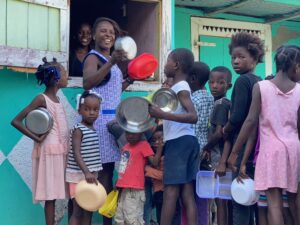 Our first Kid Feed in Sou Wòch was July 12, 2020. We have been able to continue almost every week since then as money is available. Prices of food have almost doubled, and we are feeding more kids. The cost per event was $150 at the beginning, but it now takes over $300 to feed 80-90 kids a hot meal of locally grown rice and beans, with chicken marinated and cooked in a sauce made with green pepper, onion, scallions, and garlic. It’s good food, and for many of the children, the best meal they have all week. Until recently, all the cooking was done using charcoal, which I wasn’t happy about, but last month we were able to buy a large, propane cooker and a very large cooking kettle for the rice and beans.
Our first Kid Feed in Sou Wòch was July 12, 2020. We have been able to continue almost every week since then as money is available. Prices of food have almost doubled, and we are feeding more kids. The cost per event was $150 at the beginning, but it now takes over $300 to feed 80-90 kids a hot meal of locally grown rice and beans, with chicken marinated and cooked in a sauce made with green pepper, onion, scallions, and garlic. It’s good food, and for many of the children, the best meal they have all week. Until recently, all the cooking was done using charcoal, which I wasn’t happy about, but last month we were able to buy a large, propane cooker and a very large cooking kettle for the rice and beans.
This kichen needs and upgrade.
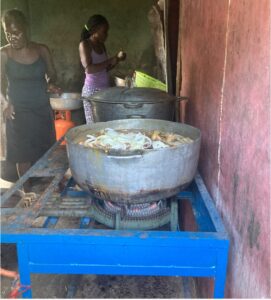
Please see the project page…
- Share This Post :
